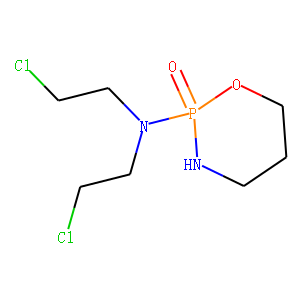| Reference | [1]. Nat Rev Clin Oncol. 2009 Nov;6(11):638-47. doi: 10.1038/nrclinonc.2009.146. Epub 2009 Sep 29.<br />
Cyclophosphamide and cancer: golden anniversary.<br />
Emadi A(1), Jones RJ, Brodsky RA.<br />
Author information: (1)Division of Adult Hematology, Johns Hopkins University, Baltimore, MD, USA. [email protected]<br />
Cyclophosphamide remains one of the most successful and widely utilized antineoplastic drugs. Moreover, it is also a potent immunosuppressive agent and the most commonly used drug in blood and marrow transplantation (BMT). It was initially synthesized to selectively target cancer cells, although the hypothesized mechanism of tumor specificity (activation by cancer cell phosphamidases) transpired to be irrelevant to its activity. Nevertheless, cyclophosphamide's unique metabolism and inactivation by aldehyde dehydrogenase is responsible for its distinct cytotoxic properties. Differential cellular expression of aldehyde dehydrogenase has an effect on the anticancer therapeutic index and immunosuppressive properties of cyclophosphamide. This Review highlights the chemistry, pharmacology, clinical toxic effects and current clinical applications of cyclophosphamide in cancer and autoimmune disorders. We also discuss the development of high-dose cyclophosphamide for BMT and the treatment of autoimmune diseases.<br />
DOI: 10.1038/nrclinonc.2009.146 PMID: 19786984 [Indexed for MEDLINE]<br />
<br />
[2]. Biol Blood Marrow Transplant. 2015 Apr;21(4):604-11. doi: 10.1016/j.bbmt.2014.08.014. Epub 2014 Aug 23.<br />
Post-transplant high-dose cyclophosphamide for the prevention of graft-versus-host disease.<br />
Al-Homsi AS(1), Roy TS(2), Cole K(2), Feng Y(2), Duffner U(3).<br />
Author information: (1)Blood and Marrow Transplantation Program, Spectrum Health, Grand Rapids, Michigan; Department of Medicine, Michigan State University, College of Human Medicine, Grand Rapids, Michigan. Electronic address: [email protected]. (2)Blood and Marrow Transplantation Program, Spectrum Health, Grand Rapids, Michigan. (3)Department of Medicine, Michigan State University, College of Human Medicine, Grand Rapids, Michigan; Helen DeVos Children Hospital, Grand Rapids, Michigan.<br />
Cyclophosphamide's lack of hematopoietic stem cell toxicity and its unique effects on the immune system have prompted several investigators to explore its potential for the prevention of graft-versus-host disease (GVHD). In haploidentical hematopoietic stem cell transplants, post-transplant cyclophosphamide together with standard prophylaxis reduces the incidence of GVHD to acceptable rates without the need for T cell depletion. In matched related and unrelated donor settings, cyclophosphamide alone has produced encouraging results. In particular, the low incidence of chronic GVHD is noteworthy. Here, we present a review of the current understanding of the mechanism of action of post-transplant cyclophosphamide and summarize the clinical data on its use for the prevention of GVHD.<br />
DOI: 10.1016/j.bbmt.2014.08.014 PMID: 25240817 [Indexed for MEDLINE]<br />
<br />
[3]. Front Immunol. 2019 Nov 29;10:2668. doi: 10.3389/fimmu.2019.02668. eCollection 2019.<br />
Mechanisms of Graft-versus-Host Disease Prevention by Post-transplantation Cyclophosphamide: An Evolving Understanding.<br />
Nunes NS(1), Kanakry CG(1).<br />
Author information: (1)Experimental Transplantation and Immunology Branch, Center for Cancer Research, National Cancer Institute, National Institutes of Health, Bethesda, MD, United States.<br />
Post-transplantation cyclophosphamide (PTCy) has been highly successful at preventing severe acute and chronic graft-versus-host disease (GVHD) after allogeneic hematopoietic cell transplantation (HCT). The clinical application of this approach was based on extensive studies in major histocompatibility complex (MHC)-matched murine skin allografting models, in which cyclophosphamide was believed to act via three main mechanisms: (1) selective elimination of alloreactive T cells; (2) intrathymic clonal deletion of alloreactive T-cell precursors; and (3) induction of suppressor T cells. In these models, cyclophosphamide was only effective in very specific contexts, requiring particular cell dose, cell source, PTCy dose, and recipient age. Achievement of transient mixed chimerism also was required. Furthermore, these studies showed differences in the impact of cyclophosphamide on transplanted cells (tumor) versus tissue (skin grafts), including the ability of cyclophosphamide to prevent rejection of the former but not the latter after MHC-mismatched transplants. Yet, clinically PTCy has demonstrated efficacy in MHC-matched or partially-MHC-mismatched HCT across a wide array of patients and HCT platforms. Importantly, clinically significant acute GVHD occurs frequently after PTCy, inconsistent with alloreactive T-cell elimination, whereas PTCy is most active against severe acute GVHD and chronic GVHD. These differences between murine skin allografting and clinical HCT suggest that the above-mentioned mechanisms may not be responsible for GVHD prevention by PTCy. Indeed, recent work by our group in murine HCT has shown that PTCy does not eliminate alloreactive T cells nor is the thymus necessary for PTCy's efficacy. Instead, other mechanisms appear to be playing important roles, including: (1) reduction of alloreactive CD4+ effector T-cell proliferation; (2) induced functional impairment of surviving alloreactive CD4+ and CD8+ effector T cells; and (3) preferential recovery of CD4+ regulatory T cells. Herein, we review the history of cyclophosphamide's use in preventing murine skin allograft rejection and our evolving new understanding of the mechanisms underlying its efficacy in preventing GVHD after HCT. Efforts are ongoing to more fully refine and elaborate this proposed new working model. The completion of this effort will provide critical insight relevant for the rational design of novel approaches to improve outcomes for PTCy-treated patients and for the induction of tolerance in other clinical contexts.<br />
DOI: 10.3389/fimmu.2019.02668 PMCID: PMC6895959 PMID: 31849930 [Indexed for MEDLINE]<br />
<br />
[4]. Australas J Dermatol. 2017 Feb;58(1):5-17. doi: 10.1111/ajd.12406. Epub 2016 Jan 24.<br />
Cyclophosphamide in dermatology.<br />
Kim J(1), Chan JJ(1).<br />
Author information: (1)Sir Charles Gairdner Hospital, Perth, Western Australia, Australia. Cyclophosphamide is a chemotherapeutic agent which was first discovered in experimental tumours in rats, and it has since been widely used to treat malignancies and severe manifestations of various auto-immune diseases. High-dose chemotherapy and continuous daily oral regimens are associated with significant toxicity profiles, but i.v. pulsed regimens have lowered the rates of adverse effects in rheumatological studies. Cyclophosphamide has been shown to be useful in the treatment of severe autoimmune conditions due to its powerful immunosuppressive ability; however, it remains a relatively underused modality in dermatology. This article reviews the current literature on cyclophosphamide and its clinical applications in dermatology.<br />
DOI: 10.1111/ajd.12406 PMID: 26806212 [Indexed for MEDLINE]<br />
<br />
[5]. Dtsch Med Wochenschr. 2001 Jul 13;126(28-29):815-8. doi: 10.1055/s-2001-15698.<br />
[Cyclophosphamide].<br />
[Article in German]<br />
Lorenz C(1), Jaehde U.<br />
Author information: (1)Universitätsklinikum Essen.<br />
DOI: 10.1055/s-2001-15698 PMID: 11499264 [Indexed for MEDLINE]
|

